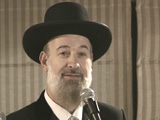- Sections
- Parashat Hashavua
34
Obviously, it has been a very long time since we have had a para aduma or have had the privilege of preparing for the Korban Pesach. The reading of Parashat Hachodesh, talking about the fundamental mitzva of Pesach, seems like a very worthwhile endeavor even if we do not end up being able to bring the korban. However, the para aduma seems to just solve a technical problem of tumah for those who happen to need it in a given year. If it is anyway not going to make a difference and we do not understand the mitzva (see Rashi, Shemot 15:26), what point does it have?
Of course, one very straightforward answer is that we very much hope – and believe is possible – that by the time Pesach comes this year, the Mikdash will indeed be standing and we will be able to do the process of preparing the para aduma ashes to purify us and bring the Korban Pesach. It is also possible that we treat matters as if we are still in the time when it was practical. However, it is also worthwhile to look at philosophical elements that are as applicable today as always.
The Akeidat Yitzchak (Bamidbar 79) explains the para aduma as not being a matter just of purification from a technical problem of tumah from contact with the dead, but of a moral purification. He explains that the para (heifer) is intrinsically a pure animal, but the redness of the special para aduma is a representation of sin. The fact that all the hairs must be red represents that if the sin does not take over completely, the para can reach personal purification by means of the other colors within it. But if it is fully representative of sin, then the only means of purification is by removing it from the encampment, and, opposite the opening to the Mikdash, slaughtering and burning it. When the Yerushalmi (Megilla 3:5) speaks of para aduma being about taharatan shel Yisrael (the purification of Israel), this is referring to the purification of teshuva more than anything else.
It is, though, seemingly strange to equate the para aduma process with repentance. After all, unless one is a kohen, there is no sin in contact with a corpse. Members of a chevra kaddisha would need the para aduma ash water sprinkled on them before entering the Mikdash or eating a Korban Pesach, even though their exposure to corpses is a great mitzva! We have written elsewhere that tumah is not about sin, but about exposure to something in the physical world that experienced a loss of life-related spiritual power. A human corpse is a physical thing that is to be respected, but it lost the neshama (with all the spiritual potential that engenders) that was within it. Such a lowering of potential can connect with a person’s inclination toward sin. Therefore, one needs to counter these dangers before proceeding to involvement in the spiritual world. This process can indeed be equated to teshuva. Thus, the para aduma!

The Intersection of the Three Eichas
Rabbi Moshe Erenreich | 6 Av 5767

Parashat Hashavua: We Want a Jewish Judicial System Now!
Rabbi Yossef Carmel | Shevat 5785

The Torah Connection
Various Rabbis | 5 Adar I 5768

Evil Eye and Tongue
Rabbi Shaul Yisraeli zt"l | 3 Iyar 5770

A Jewish Approach to Discipline in the Classroom
Rabbi David Samson | Iyar 5761

The Laws Relating to Converts
Rabbi Eliezer Melamed

What Is the Significance of the Number 40 in Jewish Tradition?
Rabbi Stewart Weiss | Tevet 4 5782

That a Cohen May Not Marry a Divorcee
Rabbi Shmuel Holshtein | 5769
Daf Yomi Makkot Daf 21
R' Eli Stefansky | 1 Iyar 5785

Parashat Hashavua: More Mila than Brit?
Rabbi Yossef Carmel | Iyar 5785

Reassuring His Parents – #314 – part I
Date and Place: 23 Sivan 5670 (1910), Yafo
Beit Din Eretz Hemda - Gazit | Iyar 5785






